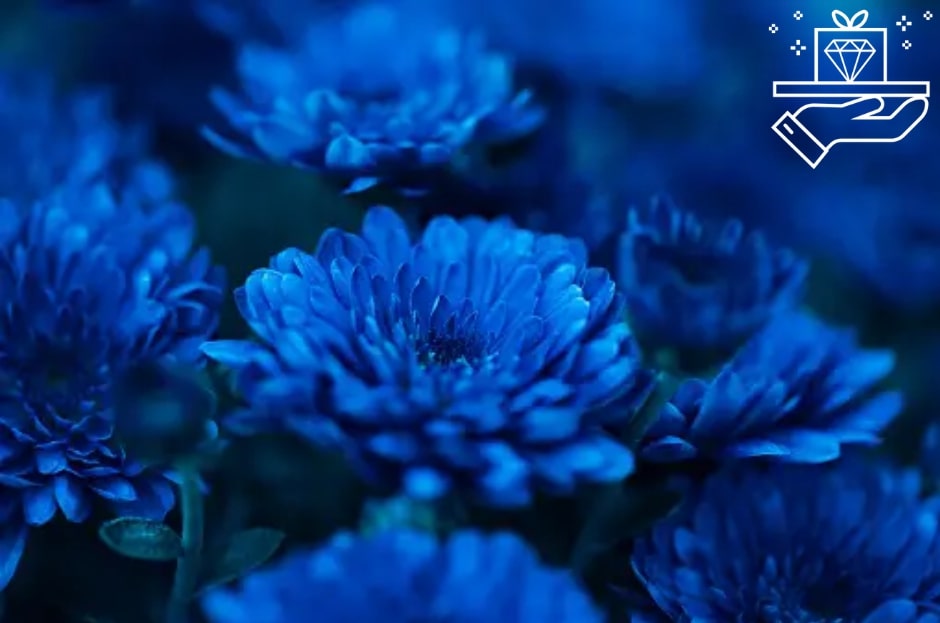Blue flowers offer a magical display of beauty and meaning. These lovely blooms bring a sense of calm, devotion, and everlasting love.
In this article, we will learn about their meanings, stories, and how to take care of them.
Blue Orchids


Botanical Name: Phalaenopsis
Origin: Southeast Asia, Australia, and the Indian subcontinent
Size: Varies, can range from miniature to large blossoms
Light: Indirect, bright light
Water: Moderate, allow the soil to dry slightly between waterings
Toxicity: Non-toxic
Blue orchids captivate flower enthusiasts and botanists with a spectrum of shades, from delicate pastels to intense hues.
Cultivating blue orchids demands meticulous care, as they thrive in environments resembling their natural habitats—high humidity, warm temperatures, filtered sunlight, and proper air circulation.
While most blue orchids available in the market are artificially colored through dyes or genetic modifications, purists treasure the rarity of naturally occurring blue orchids found in specific regions like the Himalayas and parts of Southeast Asia.
Blue Roses


Botanical Name: Rosa
Size: Varies based on the rose variety
Light: Full sun, at least 6 hours of sunlight daily
Water: Water regularly, maintaining evenly moist soil
Toxicity: Non-toxic
Blue roses are a symbol of love and romance that have fascinated people for their air of mystery and enchantment.
While not naturally occurring, modern biotechnological techniques have enabled horticulturists to create these captivating blooms through crossbreeding and genetic manipulation.
By introducing specific genes from other plants, scientists successfully produced blue roses in a range of shades, from delicate pastels to intense cobalt hues.
Today, these unique flowers serve as elegant gifts and symbols of unattainable beauty, finding a place in weddings, art, literature, and popular culture.
Blue Hydrangeas


Botanical Name: Hydrangea macrophylla
Origin: Japan and Korea
Size: Medium to large, depending on the cultivar
Light: Partial shade, avoid harsh afternoon sun
Water: Keep soil consistently moist
Toxicity: Mildly toxic if ingested
Blue hydrangeas are captivating blooms with the enchanting ability to change color based on the pH of the soil they grow in. Their voluminous, delicate petals make them popular choices for weddings and garden landscapes.
Understanding the role of soil pH is crucial in maintaining their captivating blue hues. Acidic soils produce blue blooms, and alkaline soils result in pink or purple blooms.
By incorporating aluminum sulfate or aluminum potassium sulfate into acidic soils and dolomitic lime into alkaline soils, gardeners can enhance or preserve the mesmerizing blue shades of these blooms.
With proper care, watering, sunlight exposure, and pruning, blue hydrangeas can thrive, adding a touch of magic and elegance to any garden or event.
Blue Lilies


Botanical Name: Lilium
Origin: Asia, Europe, and North America
Size: Medium to tall, depending on the species
Light: Full sun to part shade
Water: Water regularly
Toxicity: Highly toxic
Blue lilies come in various species that exude grace and elegance. Culturally significant in different parts of the world, they are often associated with purity and refined beauty.
This makes them popular choices for a wide range of events, including weddings, festivals, religious ceremonies, and offerings made in temples or sacred spaces.
In some Asian cultures, blue lilies are believed to bring good fortune and prosperity, adorning homes and temples as symbols of divine blessings.
These captivating flowers have also inspired art, literature, and poetry, representing love and the ephemeral nature of existence.
Gardening enthusiasts incorporate them into landscapes to create a sense of tranquility and sophistication.
Blue Irises


Botanical Name: Iris
Origin: Asia, Europe, and North America
Size: Medium to tall, depending on the variety
Light: Full sun
Water: Water moderately, keeping the soil consistently moist
Toxicity: Toxic if ingested, causes skin irritation upon contact
Blue irises mesmerize with their exquisite beauty, showcasing intricate petals and vibrant colors. Symbolizing faith, hope, and wisdom, these flowers inspire and uplift the human spirit.
They thrive in well-draining soil and prefer sunny spots, requiring regular watering and adequate spacing between plants. Pruning and deadheading encourage abundant blooms and maintain the garden’s picturesque appearance.
As perennials, blue irises return year after year, becoming a cherished feature for garden enthusiasts of all levels.
Bluebell Flowers


Botanical Name: Hyacinthoides non-scripta
Origin: Western Europe
Size: Small, bell-shaped flowers
Light: Partial to full shade
Water: Keep soil consistently moist during the growing season
Toxicity: Toxic if ingested
Bluebells carpet woodland floors in spring with their delicate, bell-shaped blooms. Their vibrant blue hues and graceful appearance evoke a sense of enchantment, captivating nature enthusiasts and photographers alike.
These dainty flowers hold cultural significance in folklore and myths, associated with fairies and mystical realms. In Celtic folklore, bluebells were believed to summon fairies to their gatherings, adding to their magical allure.
They also played a role in ancient rituals, symbolizing a connection between humans and nature’s spirits.
Unfortunately, bluebells face the threat of habitat destruction, making conservation efforts crucial to preserve their beauty and importance in the ecosystem.
Beyond their visual charm, bluebells contribute to biodiversity by providing early nectar for bees and pollinators. Their presence in woodlands serves as a gentle reminder of the fleeting nature of spring and the delicate balance of the natural world.
Blue Forget-Me-Nots


Botanical Name: Myosotis
Origin: Europe and Asia
Size: Small, dainty flowers
Light: Partial to full shade
Water: Keep soil consistently moist
Toxicity: Low toxicity, can cause skin irritation
True to their name, forget-me-nots display a vibrant blue hue that is hard to forget. These small yet enchanting flowers carry profound sentimental value, symbolizing everlasting love and remembrance.
The German folklore of a medieval knight and his beloved has woven a tale of undying affection around these blooms, making them cherished additions to gardens and bouquets alike.
The story revolves around a knight who met his demise while trying to get flowers for his beloved. With his final breath, he uttered the poignant words, “Forget me not!”
Growing forget-me-nots is a delightful and straightforward endeavor, as they thrive in moist, well-drained soil with partial shade. These self-seeding flowers, with their natural self-sowing ability, can surprise gardeners with their reappearance season after season.
Beyond their ornamental charm, forget-me-nots play a vital role in supporting pollinators and attracting bees and butterflies with their nectar-rich blooms.
In bouquets and floral arrangements, they carry the sentiments of love, friendship, and remembrance, becoming heartfelt tokens of affection and tribute to cherished memories.
Himalayan Blue Poppies


Botanical Name: Meconopsis betonicifolia
Origin: Himalayan region (Bhutan, Nepal, Tibet)
Size: Medium, delicate flowers
Light: Partial shade, protect from hot afternoon sun
Water: Keep the soil consistently moist soil and avoid waterlogged conditions
Toxicity: Non-toxic
Himalayan blue poppies stand out as one of the rarest and most sought-after blue flowers, native to the high-altitude regions of the Himalayas.
Their captivating allure lies in the striking blue petals, ranging from soft pastels to deep cobalt, resembling the clear skies and glaciers of their mountainous homeland.
Cultivating these blooms can be challenging due to their specific care requirements, preferring cool and moist environments with partial shade.
However, for those who succeed, the reward is a breathtaking display of mesmerizing blue hues that make them a coveted addition to any garden.
Symbolizing beauty and rarity, Himalayan blue poppies have become a treasure sought after by gardeners and collectors alike.
Their scarcity and demanding cultivation needs contribute to their allure, making them an emblem of accomplishment for those who manage to nurture these elusive flowers.
Blue Daisies


Botanical Name: Agapanthus
Origin: South Africa
Size: Medium, globe-shaped clusters of flowers
Light: Full sun to part shade
Water: Water regularly
Toxicity: Mildly toxic if ingested
Blue daisies enchant with their simplicity and serene beauty while adding a touch of tranquility to any landscape. These cheerful flowers exude happiness and positivity, brightening up gardens with their vibrant blue hues.
With a wide variety of species and cultivars available, blue daisies offer an artistic canvas of nature’s creativity, each boasting its own distinctive petal arrangement and color variation.
Cultivating blue daisies is a rewarding experience, as they are relatively easy to grow with proper care. They thrive in well-draining soil, prefer full to partial sunlight, and benefit from adequate watering during their growing season.
Attracting pollinators like bees and butterflies, blue daisies contribute to the ecological balance of the garden. Beyond their aesthetic appeal, these charming blooms symbolize trust, loyalty, and fidelity in the language of flowers.
Blue Balloon Flowers


Botanical Name: Platycodon grandiflorus
Origin: East Asia
Size: Small to medium
Light: Full sun to light shade
Water: Water regularly
Toxicity: Non-toxic
Blue balloon flowers mesmerize with their playful charm, featuring balloon-like buds that unfurl into stunning star-shaped blue petals. These flowers are hardy perennials, adapting well to various conditions, thriving in well-draining soil and full sunlight.
They boast a prolonged blooming period, gracing gardens with vibrant blue blooms from late spring to early fall, making them a lasting and eye-catching feature.
Beyond their ornamental value, balloon flowers have been used in traditional medicine for their potential health benefits, particularly in supporting respiratory health and alleviating coughs.




